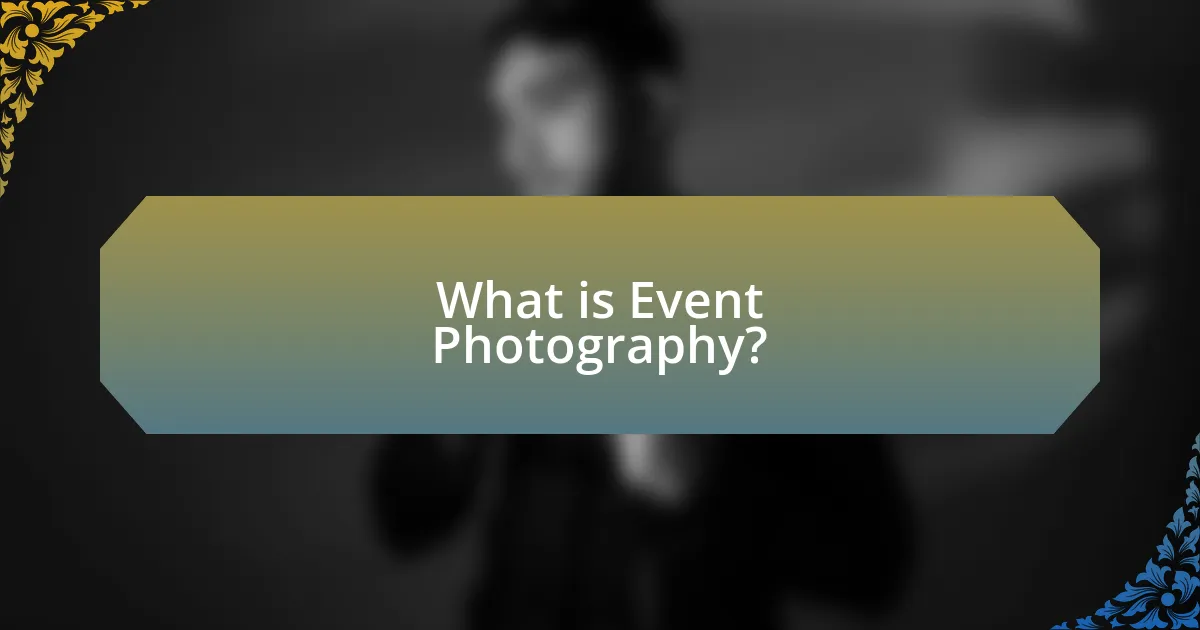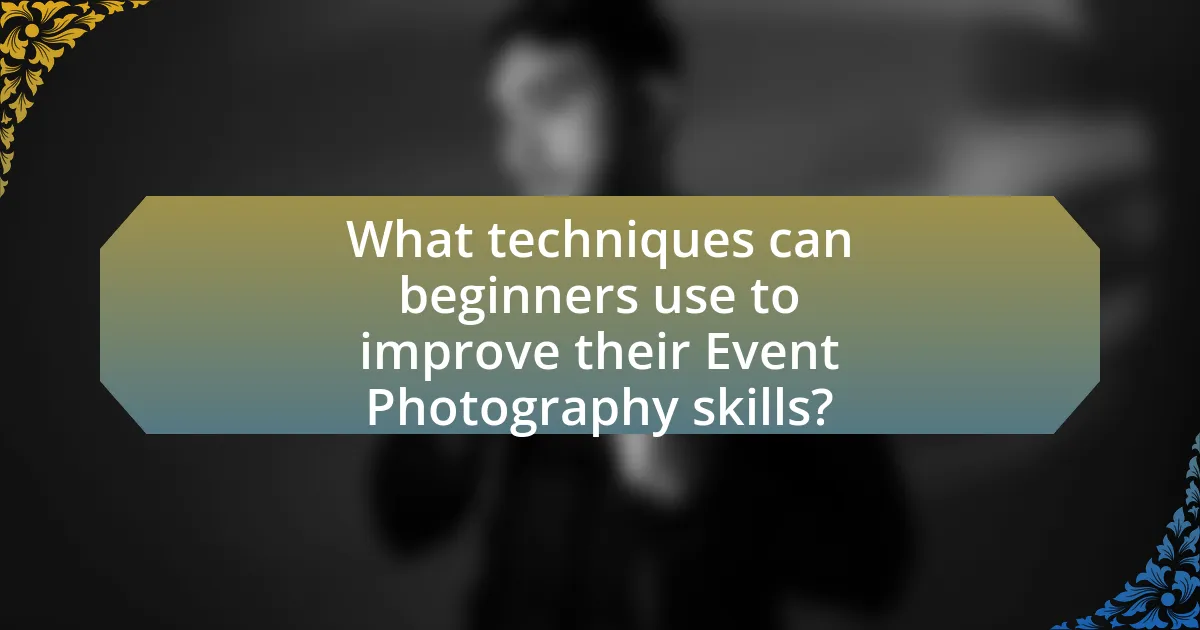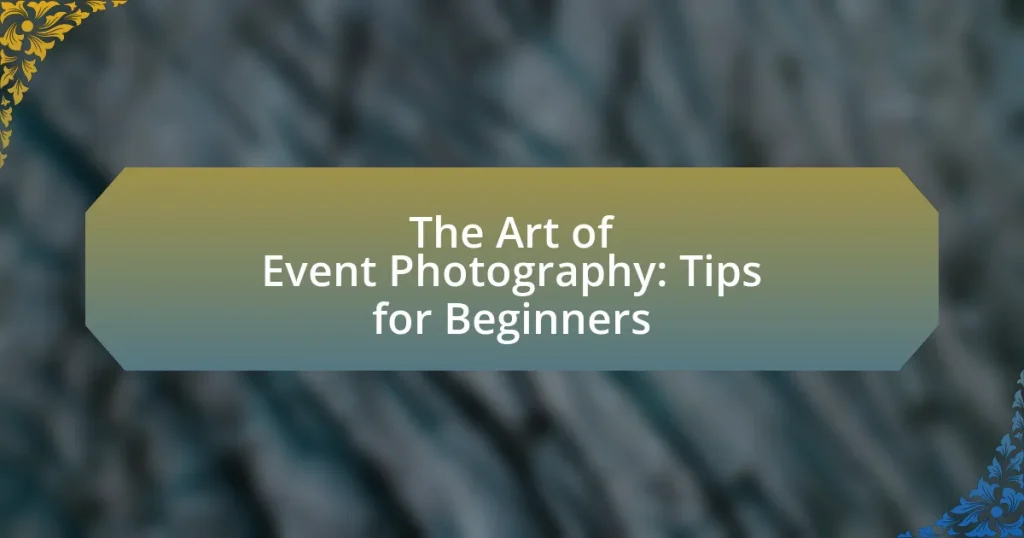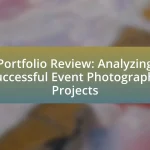Event photography is a specialized genre focused on capturing the essence of live events such as weddings, corporate gatherings, and concerts. This article provides a comprehensive overview of event photography, detailing its unique characteristics, the importance of storytelling, and the types of events commonly photographed. It also addresses the essential equipment and techniques needed for success, including camera settings, lens choices, and composition strategies. Additionally, the article highlights common challenges faced by photographers in various settings and offers practical tips for beginners to enhance their skills and effectively communicate with clients.

What is Event Photography?
Event photography is the practice of capturing images during events such as weddings, corporate gatherings, parties, and concerts. This genre of photography focuses on documenting the atmosphere, emotions, and key moments of the event, providing a visual narrative that reflects the experience. Event photographers often work in dynamic environments, requiring them to be adaptable and skilled in various lighting conditions and compositions to effectively convey the essence of the occasion.
How does Event Photography differ from other photography genres?
Event photography primarily differs from other photography genres in its focus on capturing live moments and interactions during specific occasions, such as weddings, parties, or corporate events. Unlike portrait or landscape photography, which often emphasizes staged or static subjects, event photography requires the photographer to be adaptable and responsive to spontaneous moments, ensuring that key events and emotions are documented in real-time. This genre also often involves working under varying lighting conditions and managing crowds, which adds complexity compared to other photography styles that may have more controlled environments.
What are the key characteristics of Event Photography?
Event photography is characterized by its focus on capturing moments during events, emphasizing spontaneity, emotion, and storytelling. Key characteristics include the ability to work in various lighting conditions, the skill to anticipate key moments, and the use of candid shots to convey the atmosphere of the event. Additionally, event photographers often employ a mix of posed and unposed images to create a comprehensive narrative of the occasion. The importance of technical proficiency in camera settings and composition further supports the effectiveness of event photography in documenting significant life events, such as weddings, corporate functions, and parties.
Why is storytelling important in Event Photography?
Storytelling is important in event photography because it captures the essence and emotions of the event, creating a narrative that resonates with viewers. By focusing on key moments, interactions, and the atmosphere, photographers can convey the story behind the event, making the images more engaging and memorable. Research indicates that images that tell a story are more likely to evoke emotional responses, enhancing the viewer’s connection to the event. This narrative approach not only documents the event but also transforms it into a compelling visual experience that can be shared and appreciated long after the event has concluded.
What types of events are commonly photographed?
Commonly photographed events include weddings, corporate events, parties, concerts, and sports events. Weddings are particularly significant, with over 2 million weddings occurring annually in the United States alone, making them a primary focus for photographers. Corporate events, such as conferences and product launches, also require professional photography to capture key moments and branding. Parties, including birthdays and anniversaries, are frequently documented to preserve memories. Concerts attract photographers to capture live performances and audience engagement. Sports events are photographed to highlight athletic achievements and team spirit, with millions of fans attending various sporting events each year.
How do weddings influence Event Photography techniques?
Weddings significantly influence event photography techniques by necessitating a blend of candid and posed shots to capture the emotional essence of the day. Photographers adapt their approaches to include various styles, such as documentary photography, which focuses on capturing spontaneous moments, and traditional portraiture, which emphasizes formal family and couple portraits. This duality is essential because weddings often involve a wide range of emotions and interactions, requiring photographers to be versatile in their techniques.
Moreover, the fast-paced nature of weddings demands that photographers master techniques like quick reflexes and the ability to anticipate key moments, such as the exchange of vows or the first dance. According to a study by the Wedding Photojournalist Association, 70% of couples prefer a mix of candid and posed images, highlighting the importance of adaptability in photography styles. This adaptability not only enhances the storytelling aspect of wedding photography but also ensures that photographers can meet diverse client expectations effectively.
What unique challenges do corporate events present for photographers?
Corporate events present unique challenges for photographers, primarily due to the need for professionalism and the dynamic nature of the environment. Photographers must navigate strict schedules, ensuring they capture key moments while adhering to time constraints. Additionally, corporate settings often involve varying lighting conditions, which can complicate exposure settings and require quick adjustments. The presence of multiple stakeholders, including executives and clients, necessitates a focus on capturing formal interactions and candid moments without intruding on conversations. Furthermore, photographers must be adept at managing expectations, as corporate clients often have specific branding and messaging requirements that must be reflected in the imagery. These factors collectively demand a high level of adaptability and technical skill from photographers in corporate environments.

What essential equipment is needed for Event Photography?
Essential equipment needed for event photography includes a DSLR or mirrorless camera, a variety of lenses, external flash, memory cards, and a tripod. A DSLR or mirrorless camera is crucial for capturing high-quality images in various lighting conditions, while interchangeable lenses allow for versatility in framing shots. An external flash is important for illuminating subjects in low-light environments, and ample memory cards ensure that photographers can store numerous images without interruption. A tripod provides stability for long exposure shots and helps maintain sharpness in images. These items are fundamental for achieving professional results in event photography.
How do camera settings impact Event Photography results?
Camera settings significantly impact event photography results by influencing exposure, focus, and motion capture. For instance, adjusting the aperture affects depth of field, allowing photographers to isolate subjects against blurred backgrounds, which enhances the visual appeal of images. Shutter speed settings determine how motion is captured; faster speeds freeze action, while slower speeds can create motion blur, adding dynamism to the scene. ISO settings control the camera’s sensitivity to light; higher ISO values enable shooting in low-light conditions but may introduce noise, affecting image quality. These settings collectively determine the clarity, composition, and overall aesthetic of event photographs, making them crucial for achieving desired outcomes.
What are the best camera settings for low-light events?
The best camera settings for low-light events include using a wide aperture (f/1.8 to f/2.8), a higher ISO (800 to 3200), and a slower shutter speed (1/60 to 1/125 seconds). A wide aperture allows more light to enter the lens, enhancing brightness in dim conditions. Increasing the ISO sensitivity enables the camera to capture more light, although it may introduce noise at higher settings. A slower shutter speed compensates for reduced light, but it requires steady hands or stabilization to avoid motion blur. These settings are commonly recommended by photographers for effective low-light performance.
How does lens choice affect the outcome of event photos?
Lens choice significantly affects the outcome of event photos by influencing factors such as depth of field, perspective, and light capture. For instance, a wide-angle lens allows photographers to capture more of the scene, making it ideal for large gatherings, while a telephoto lens can isolate subjects from the background, creating a more intimate feel. Additionally, lenses with larger apertures, like f/1.8 or f/2.8, enable better performance in low-light conditions, which is often crucial during events held indoors or at night. This capability enhances image quality by reducing motion blur and improving sharpness, as evidenced by studies showing that images taken with faster lenses in low light retain more detail compared to those taken with slower lenses. Thus, the choice of lens directly impacts the composition, clarity, and overall aesthetic of event photography.
What accessories should every event photographer consider?
Every event photographer should consider using a sturdy tripod, external flash, and extra batteries. A sturdy tripod stabilizes the camera for long exposures and low-light situations, ensuring sharp images. An external flash provides better lighting control compared to built-in camera flashes, which can lead to harsh shadows and unflattering results. Extra batteries are essential because event photography often requires extended shooting periods, and having backups prevents interruptions due to power loss. These accessories enhance the quality and reliability of the photography experience during events.
How can external flashes enhance event photography?
External flashes enhance event photography by providing controlled lighting that improves image quality and reduces harsh shadows. They allow photographers to illuminate subjects effectively in low-light environments, ensuring that details are captured clearly. For instance, using an external flash can increase the dynamic range of images, making colors more vibrant and skin tones more natural. Additionally, external flashes can be adjusted for different angles and intensities, enabling creative lighting techniques such as bounce flash, which softens the light and creates a more flattering effect. This versatility is crucial in event photography, where lighting conditions can vary significantly.
What role do tripods and stabilizers play in capturing quality images?
Tripods and stabilizers are essential tools in capturing quality images as they provide stability and reduce camera shake. By securing the camera in a fixed position, tripods allow for longer exposure times without blurring, which is crucial in low-light conditions or when using slow shutter speeds. Stabilizers, such as gimbals, help maintain smooth motion during video capture or while shooting in dynamic environments, ensuring that images remain clear and focused. Research indicates that using a tripod can improve image sharpness by up to 300% in certain scenarios, demonstrating their significant impact on image quality.

What techniques can beginners use to improve their Event Photography skills?
Beginners can improve their event photography skills by mastering composition, understanding lighting, and practicing candid shots. Composition techniques, such as the rule of thirds, help create visually appealing images by guiding the viewer’s eye. Understanding natural and artificial lighting allows photographers to capture subjects in the best possible conditions, enhancing image quality. Practicing candid shots enables beginners to capture genuine emotions and interactions, which are often the essence of event photography. These techniques are widely recognized in photography education and are essential for developing a strong foundational skill set.
How can composition enhance the storytelling aspect of event photos?
Composition enhances the storytelling aspect of event photos by guiding the viewer’s eye and emphasizing key elements within the frame. Effective composition techniques, such as the rule of thirds, leading lines, and framing, help to create a narrative by highlighting important subjects and their interactions. For instance, placing a subject off-center can create tension or interest, while using leading lines can draw attention to a focal point, thereby enhancing the overall story being conveyed. Studies in visual perception indicate that well-composed images are more engaging and memorable, as they facilitate a clearer understanding of the context and emotions present in the scene.
What are the rules of composition that every beginner should know?
The rules of composition that every beginner should know include the rule of thirds, leading lines, framing, symmetry, and depth. The rule of thirds involves dividing the image into a 3×3 grid and placing key elements along the lines or at their intersections to create balance. Leading lines guide the viewer’s eye through the photograph, enhancing depth and perspective. Framing uses elements within the scene to create a “frame” around the subject, drawing attention to it. Symmetry creates a sense of harmony and balance, while depth can be achieved by including foreground, middle ground, and background elements to add dimension. These foundational principles are essential for creating visually appealing photographs.
How can framing and perspective change the viewer’s experience?
Framing and perspective significantly alter the viewer’s experience by influencing how subjects are perceived and the emotions evoked. For instance, a tight frame can create intimacy, drawing attention to specific details, while a wide perspective can establish context and convey a sense of scale. Research in visual perception indicates that framing can guide the viewer’s focus, as demonstrated in studies showing that images with intentional framing lead to stronger emotional responses compared to unframed images. This illustrates that the way a photograph is composed directly impacts the narrative and emotional engagement of the viewer.
What are some tips for capturing candid moments during events?
To capture candid moments during events, photographers should focus on being unobtrusive and anticipating moments. Using a longer lens allows for distance, enabling the photographer to capture genuine interactions without intruding. Additionally, staying alert to the environment and observing subjects’ body language can help identify potential candid opportunities. Research indicates that candid photography often results in more authentic expressions, as subjects are less aware of the camera, leading to natural moments being documented.
How can a photographer blend into the background to capture genuine emotions?
A photographer can blend into the background to capture genuine emotions by adopting a low-profile approach, using unobtrusive equipment, and maintaining a calm demeanor. This technique allows the photographer to become less noticeable, which encourages subjects to act naturally and express authentic feelings. For instance, using a longer lens enables the photographer to shoot from a distance, minimizing their presence while still capturing intimate moments. Additionally, wearing neutral clothing helps the photographer avoid drawing attention, further facilitating a relaxed environment. Studies in social psychology indicate that individuals are more likely to exhibit genuine emotions when they feel unobserved, supporting the effectiveness of this blending strategy.
What strategies can be used to anticipate key moments during an event?
To anticipate key moments during an event, photographers should employ strategies such as thorough pre-event research, understanding the event schedule, and maintaining situational awareness. Pre-event research involves familiarizing oneself with the event’s purpose, key participants, and potential highlights, which allows photographers to identify critical moments to capture. Understanding the event schedule helps in predicting when significant activities will occur, such as speeches or performances, enabling photographers to be in the right place at the right time. Maintaining situational awareness involves observing interactions and emotional cues among attendees, which can signal spontaneous moments worth capturing. These strategies enhance the likelihood of capturing impactful images that tell the story of the event effectively.
How can beginners effectively communicate with clients and subjects?
Beginners can effectively communicate with clients and subjects by actively listening, asking clarifying questions, and maintaining a professional demeanor. Active listening ensures that photographers understand the needs and expectations of clients, which is crucial for delivering satisfactory results. Asking clarifying questions helps to eliminate misunderstandings and ensures that both parties are aligned on the project goals. Maintaining a professional demeanor fosters trust and respect, which are essential for building strong relationships in event photography. According to a study published in the Journal of Business Communication, effective communication significantly enhances client satisfaction and project outcomes, highlighting the importance of these skills in professional settings.
What questions should photographers ask clients before an event?
Photographers should ask clients about the event’s date, time, and location to ensure proper scheduling and logistics. Additionally, they should inquire about the event’s purpose and theme, which helps in capturing the right mood and style. Understanding the client’s expectations regarding specific shots or moments to capture is crucial for meeting their needs. Photographers should also ask about the guest list to prepare for group photos and any restrictions or guidelines from the venue. Finally, discussing the budget and deliverables, such as the number of edited photos and the timeline for delivery, is essential for aligning expectations.
How can photographers build rapport with subjects for better candid shots?
Photographers can build rapport with subjects for better candid shots by engaging in genuine conversation and showing interest in their stories. Establishing a connection through active listening and empathy allows subjects to feel comfortable and relaxed, which is essential for capturing authentic moments. Research indicates that when individuals feel understood and valued, they are more likely to express themselves naturally, leading to more compelling candid photographs.
What are common mistakes to avoid in Event Photography?
Common mistakes to avoid in event photography include poor lighting management, lack of preparation, and not capturing key moments. Poor lighting can lead to grainy or poorly exposed images, which detracts from the quality of the photographs. Lack of preparation, such as not scouting the venue beforehand, can result in missed opportunities for great shots. Additionally, failing to anticipate and capture key moments, like speeches or special interactions, can leave significant gaps in the event’s visual narrative. These mistakes can diminish the overall impact of the photography and fail to convey the essence of the event.
How can poor lighting affect the quality of event photos?
Poor lighting significantly diminishes the quality of event photos by causing issues such as underexposure, overexposure, and increased noise. Underexposed images lack detail in shadows, making subjects appear dark and indistinct, while overexposed images lose detail in highlights, resulting in washed-out areas. Additionally, low light conditions often lead to increased noise, which manifests as graininess, further degrading image quality. Studies show that optimal lighting conditions can enhance clarity and color accuracy, making well-lit photos more visually appealing and professional.
What are the pitfalls of not preparing adequately for an event shoot?
Not preparing adequately for an event shoot can lead to missed opportunities for capturing key moments, resulting in incomplete coverage of the event. This lack of preparation may cause photographers to overlook essential equipment checks, such as battery life and memory card availability, which can lead to technical failures during critical moments. Additionally, insufficient knowledge of the event schedule can result in being in the wrong place at the wrong time, missing important interactions or highlights. According to a survey by the Professional Photographers of America, 70% of photographers reported that inadequate preparation directly impacted their ability to deliver satisfactory results to clients.
What practical tips can help beginners succeed in Event Photography?
To succeed in event photography, beginners should focus on mastering their camera settings, understanding lighting conditions, and practicing composition techniques. Familiarizing oneself with the camera’s manual settings allows for better control over exposure, shutter speed, and ISO, which are crucial in varying lighting situations. Additionally, learning to identify and utilize natural light, as well as employing external flash when necessary, enhances image quality. Practicing composition techniques, such as the rule of thirds and framing, helps create visually appealing photographs. These foundational skills are supported by numerous photography resources and tutorials that emphasize the importance of technical proficiency and artistic vision in capturing memorable event moments.















